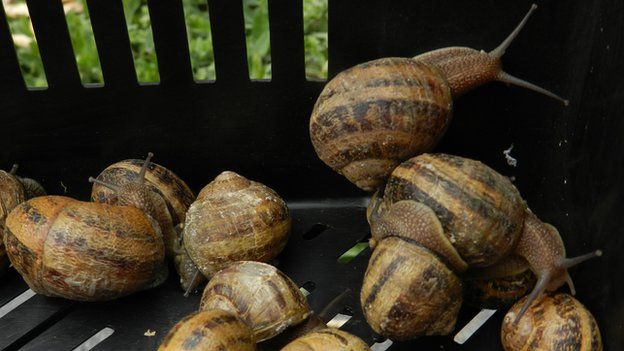Austria's only snail farmer
- Published

In a dark barn on a farm on the outskirts of Vienna, Andreas Gugumuck is preparing the "love room" for the multiple guests that come to stay.
His role is to provide atmospheric lighting, and a steady supply of snacks for those visitors who want to take a break from being amorous with numerous partners.
Yet Mr Gugumuck isn't running some sort of guest house of disrepute; he is in fact breeding snails.
The 40-year-old is Austria's only full-time professional snail farmer, producing 300,000 per year for human consumption.
With 1kg of snail meat selling for up to 80 euros ($105; £63) it is a lucrative business.
Mr Gugumuck sells up to 1.5 tonnes of snails per year to restaurants across Austria, and via exports, predominantly to Germany and the US.
And he recently flexed his entrepreneurial muscles by diversifying into selling snail caviar - yes, snail eggs - and snail livers.
He says it is a significantly more enjoyable job than his previous life working in IT.
Historic Austrian food
Mr Gugumuck grew up on a farm, but had no interest in taking it over from his father.
So instead he did a degree in computer science and economics, and then joined the Austrian branch of IT giant IBM in 2000, where he held a number of positions, rising to project manager.
But Mr Gugumuck says "there was something missing".
"I produced nothing, just words and concepts, and so I looked about at alternatives, and then I read this article about snails being used again in haute cuisine.
"Then I researched a little about snails, and I found a very famous cookbook, and in this cookbook I read about the big, historic tradition - especially here in Vienna - about snails being eaten during Lent."
For while France is today the biggest consumer of snails, or escargots as they are called in French, Mr Gugumuck discovered that in the Middle Ages, it was in fact Vienna that was the centre of snail eating.
He adds that at the time Vienna was devoutly Roman Catholic, and people were forbidden from eating meat during Lent - the six weeks before Easter.
As snails were not considered to be meat, there was huge demand for them during the period.
Yet as the centuries progressed, eating snails all but disappeared in Austria. That is until Mr Gugumuck was inspired to try to bring it back.
Snail facts
- The process of raising snails for human consumption is known as heliciculture
- It typically takes three to six months for a snail egg to hatch and grow into a full-sized adult
- Snails have been eaten by humans for thousands of years
- The three main varieties eaten in Europe are the Burgundy, brown and lucorum snails
- Most snails consumed in Europe are farmed in Poland
- The French remain the world's biggest consumers of snails, getting through more than 30,000 tonnes per year
- Snails in France are typically served in a garlic butter sauce
- Before being cooked, snails are typically not fed for two days to remove any toxins they may have recently consumed
Promotional fairs
After researching the breeding conditions of snails, Mr Gugumuck took over his grandmother's small farm in 2008.
From November to May he prepared a field with salad crops and herbs such as thyme, and in May he bought 20,000 snails of the variety known as cornu aspersum, or the European brown snail.
This is the most common type of snail that people living in northern Europe, including the UK, will find in their gardens.
After harvesting his first snail crop, Mr Gugumuck then experimented with how best to cook them, as the great majority of restaurants buy their snails pre-cooked.
Simmering them for three hours in a vegetable broth, he then took them to the best restaurants in Vienna.
Mr Gugumuck says that while the chefs liked the quality of his snails, many were reluctant to buy them as they didn't think their customers would order them.
So to help drum up interest and enthusiasm, Mr Gugumuck decided to organise two snail-eating festivals, one during Lent, and the other in September.
The popularity of these festivals - which continue to take place each year - helped to convince Vienna's restaurants, and Mr Gugumuck's sales soon started to rise.
By 2010 his business, Viennese Snails, was making enough money for him to quit his IT job and go full-time.
Farm tours
In recent years, Mr Gugumuck has also harvested both snail eggs and livers.
To get the eggs, the snails - which are hermaphrodites - are placed in boxes filled with earth and sand, from where the eggs can be harvested every other day.
The eggs, which are white in colour, are pasteurised before sale in small jars. They can cost more than 150 euros for 50g.
They are said to have more of a crunch than fish eggs, and a strong earthy taste.
Most of Mr Gugumuck's snail eggs are exported to Germany and the US.
Yet he is more proud of his snail livers, which are removed by hand, because they are an even rarer product.
"The snail's liver has the same spiral shape as the shell, that's the crazy thing.
"I like the taste because it is very soft. It also has a very fine, nutty taste and is a beautiful complement to fish, also in a fried white omelette."
Mr Gugumuck also makes additional income by running tours of his farm, where he is building a restaurant and shop area.
He is also developing his own beauty product using snail slime.
Snails may move slowly, but Mr Gugumuck's business is continuing to grow at an impressive pace.